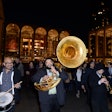
When this year's Golden Globe awards ceremony ended, it was only the beginning of a long night for some would-be after-party guests in Los Angeles. Guests instructed to arrive at an off-site parking garage location and be transported to the Beverly Hilton on shuttles encountered an hours-long backup that infuriated V.I.P.s and dashed plans for the evening—and made for big news across the country.
The incident demonstrated just how much shuttles or other transportation arrangements are key to an event’s success. Industry pros offer tips for creating a smooth flow in and out of an event, avoiding delays and discomforts.
1. Know your guests.
Erik Elliott, director of operations for Chicago-based V.I.P. Valet Services, says the first step in a successful transportation experience is knowing your guests. This includes knowing how old they are and if they have mobility issues, whether they will have luggage, whether they have connectivity needs, and whether there are people who need to ride together or necessarily be kept separate. “You need to review your demographic and at times make assumptions,” he says. “Online apps [that collect information about] attendees have given us the tools to make this easier to do in real time.”
2. Make it personal and comfortable.
Elliott suggests planners consider on-brand or otherwise personal details like a custom soundtrack or presentation. “Ask through the intercom if anyone would like the temperature adjusted, and make sure the bus is given ample time to either heat or pre-cool before loading passengers.” He also proposes having bottled water available and having a plan to check for lost-and-found items.
Louis Veliz, the director of business development for Redwood City, California-based Mosaic Global Transportation, adds, “The little things are all part of the experience—those things are lasting impressions.”
3. Arrange a standby vehicle.
Veliz says he always recommends having a backup vehicle on hand throughout the event's full timeline. This option can be smaller and more nimble, and available as a plan B in case a V.I.P. needs to be rerouted without scrambling the transportation schedule for other guests, or if other guests find themselves with an unscheduled change to location or timing.
4. Book more seats than you need.
If an event’s guest list includes 100 people, should a planner just arrange for 100 seats on shuttles? No, says Richard Fertig, president and C.E.O. of New York-based Brilliant Transportation. “Get more seats than you need, so that not every seat needs to be full every single time,” he says. Having more seats on vehicles than are needed allows them to move before all seats are fully filled—or when even just a few V.I.P.s are onboard—which cuts down on guests’ wait time.
And of course, planners shouldn't forget the round trip. Guests can become enraged when significant backups occur—and this goes for the way to the event, as well as the way out. “Oftentimes when are guests are ready to leave, they want out,” Elliott says. “They don’t want to sit on a shuttle for 20 minutes as more and more guests continue to load to capacity.” His team limits wait times to a maximum of seven or 10 minutes and has a ground person checking vestibules and monitoring doors to give the driver the final O.K.
5. Don’t be fooled by distance.
Fertig says there’s a danger in planners underestimating their transportation needs based on a short distance between the pickup spot and event space. “What we find is that things may be so close, just a mile or so away—but [the amount of time required to transport people] has everything to do with the turn radius, the way people get in and get out [of vehicles], etc.,” he says. “Oftentimes, planners take some comfort in the close distance and say, ‘We can load these vehicles in five minutes each.’ But it can take 10 or 15 minutes to just stage the vehicle at the loading place, and there could be clearance issues or tight turns.”
6. Do dry runs.
Such issues can be discovered by doing dry runs, which Fertig says Brilliant conducts using actual vehicles on the same day of the week, and at the same time as the event, as close to the event as possible, given changes could occur with construction or lane closures.
Regarding dry runs, Elliott says: “You need to look at the factors that are going to influence transportation to your event, including weather, traffic, congruent or competing events, and security issues. You need to go at the same time your event would take place to determine if your plan is valid.” He suggests bringing a stopwatch, making the trip several times, and following the same route. “Don’t take your best time—err on the side of caution,” he says.
7. Staff wisely.
Fertig says the staff should be friendly, hospitable, professional—and on-brand. “In many cases, they are real models wearing uniforms owned by a fashion house,” he says of some past events he’s worked on. “It’s not someone barking orders to you like at Disney World.”
Elliott argues that staff should be easily identifiable so that they may quickly assist with corralling guests. He also says there should be a point person dedicated to transportation, who should “be the director of the orchestra, pulling and pushing to massage the group to get to where they need to go and stay on timeline. This person needs to have a relationship with the drivers and a communication system.”
8. Make transportation feel like part of the event.
The more guests feel like transportation is a chore separate from the event, the less happy they will be with the experience. If attendees view the experience as part of their networking time or their evening out, they will be more patient and comfortable. “It should match the rest of the event—it should be flawless,” Fertig says.



















